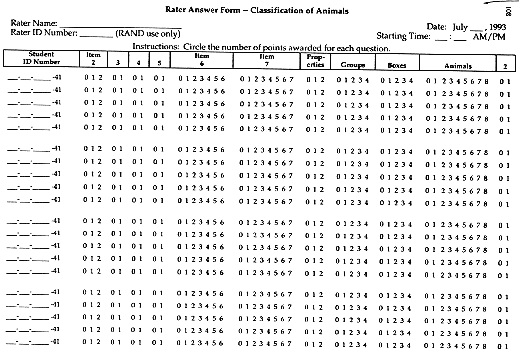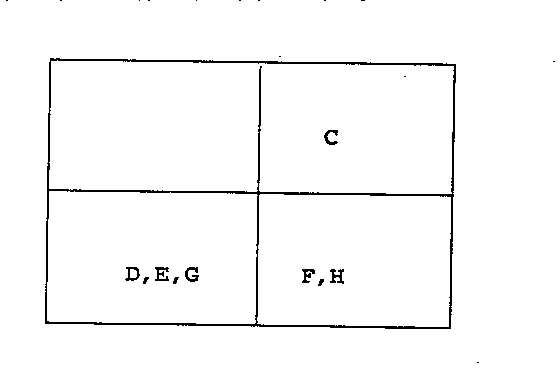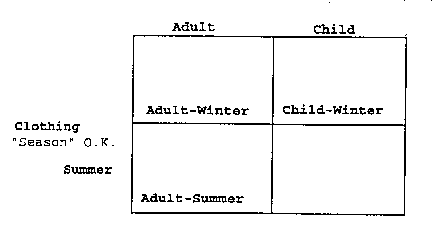COLUMN GROUPS: (2 points)
To get the 2 points for the column labels, the groups must
meet TWO criteria:
- Both groups must be part of the same variable. This means
that the 2 groups in a column must be mutually exclusive.
- There must be corroborating evidence of student understanding.
This can be demonstrated by any one of the following methods:
- Does the PROPERTY label fit both groups? (e.g. the
property "Size" fits the groups "Big" and "Small") If
not, then
- Are the LABELS INSIDE THE BOXES consistent with the
column group labels? If NOT, then
- Are the ANIMALS in each column sorted in a way that
is consistent with the group label for that column? (It
does not have to be perfect).
50% rule: If 50% or more of the animals in a
column fit the label for that column, then it corroborates
the column label. Both labels must be corroborated for
the student to get credit for the group labels.
- COLUMN PROPERTY: (1 point) Both column groups must fit
the property.
MAMMAL RULE: Student does not receive a point if
he or she uses the same label for a group and for the corresponding
property, unless student says "OR," uses a question mark,
or somehow recognizes a dichotomy between the groups in
the property label. For example, "mammal" is not OK, but
"mammal or not mammal" is OK.
NOTE: If a student uses the same property or group labels
for the rows and columns, he/she can only receive points
once.
- ROW GROUPS: (2 points)
Same criteria as column groups (see above).
- ROW PROPERTY: (1 point)
Both row groups have to fit the property (see above).
- BOX LABELS: (1 point each up to 4 points)
Each inside box label must match its outside row AND column
group labels. Close synonyms are acceptable (e.g., outside
group label is "Big" and the corresponding box label says
"large," this is OK).
- ANIMALS: (1 point each up to 8 points)
Does the animal fit the box? Give first priority to the outside
group labels. Animals placed in more than one box cannot receive
a point. A student can get all 8 points for animals only if
every box has at least 1 animal. If this rule is not satisfied,
but all the animals are classified properly, then assign a
score of "7" for animals.
See page 9 "Specific Rules for Scoring Animals" for guidelines
on ambiguous groupings, such as "big/small." Remember,
a student can get points here even if he or she did not
get points for the groups (see "Special Cases," p.5).
QUESTION #2 (p.5)- (1 point)
Student receives 1 point if his or her response is accurate
relative to his or her own classification system. Student must
identify a box or boxes, or give valid reasons for not placing
the objects in a box.
GIVE POINT IF ANY OF THE STUDENTS EXPLANATION CONTAINS
ANY OF THE FOLLOWING:
a) A unique box label that is valid (applies to characteristics
of the alligator) - for example, lays eggs.
b) Row and column labels that are valid - for example, big
and water.
c) Box number AND either row or column label, both of which
are valid.
d) Student mentions more than one box and gives valid reason
for why the object fits into each box - for example, can go
in Box 1 (land/big) or Box 2 (water/big).
e) Student says object doesn't fit any box and gives a valid
reason that is consistent with his or her system.
Give the student a point if the explanation satisfies one or
more of the rules above. A student who does not receive a point
is most likely to:
a) provide a box number only, with no reason (needs at least
one word).
b) Put object in a box and provide a reason that is inconsistent
with his or her labels or classification system.
c) Mention a row or column without specifying a particular
box or stating why both boxes would be applicable.
If there is an internal conflict (e.g., fits box label but
not row and column labels), student gets the benefit of the
doubt and receives a point.
SPECIAL CASES:
a) one or both sets of groups labels do not constitute levels
of a variable (e.g., big and dark).
AND
b) Student has a valid cross-classification within the
table.
Ways in which this may occur:
- Outside labels do not represent levels of a variable, but
student uses these to create a cross classification inside
the table and this cross-classification makes sense. (See
"pointy faces" example from calibration and example 1a in
this handout.)
- SCORING: No points for group labels that are not levels
of a variable. 1 point awarded for each correct box label
(box label that contains each of the corresponding row
and column labels) 1 point awarded for each properly classified
animal.
- Group labels are missing but the box labels show a valid
cross-classification. (See example 2a in this handout.)
SCORING: No points awarded for groups or properties. No
points awarded for boxes. 1 point awarded for each properly
classified animal.
- Group labels conflict with the box labels inside
the table, but the box labels and animals form a valid cross-classification
within the table. (See example 3a in this handout).
- SCORING: Points awarded for groups only if they can
be corroborated by an appropriate property label. No points
awarded for boxes. 1 point awarded for each properly classified
animal.
IMPORTANT:
In order for a student to receive points for animals in these
special cases:
a) There must be evidence that the row group applies to both
boxes in the row; in other words, the student must have at least
one animal that fits the group label in each of the boxes
in that row. There must also be evidence that the column group
applies to both boxes in the column; student must have at least
one animal that fits the column label in each of the
boxes in that column.
b) 50% Rule: At least 50% of the animals in each row must fit
that row, whether the student is using external labels or box
labels. At least 50% of the animals in each column must fit
that column.
SPECIFIC RULES FOR SCORING ANIMALS
Animal Sizes
Student has groups based on animal sizes (e.g., big/small).
| Must Always Be Big |
Must Always Be Small |
Flexible |
Elephant
Whale |
Chicken
Duck/Goose |
Dog
Seal
Shark
Tiger |
Light/Dark Animals
Student uses "light" and "dark" as groups (exactly these words).
| Must Always Be Dark |
Must Always Be Light |
Flexible |
Seal
Whale |
Shark
Duck/Goose |
Dog
Elephant
Tiger |
Animal Colors
Student has groups based on how colorful the animals are. Colorful,
Multicolored, and "more than 1 color" should be considered the
same thing
| Must Always Be Multicolored |
Must Always Be One Color |
Flexible |
Dog
Tiger
Whale |
Elephant |
Chicken*
Duck
Seal
Shark |
* If the chicken is one color then the duck MUST also be considered
one color in the student's system. But, the duck can be one
color without the chicken also being considered one color.





